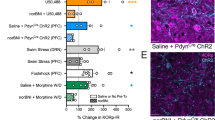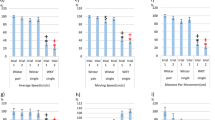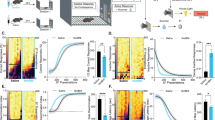Abstract
The Wistar Kyoto (WKY) rat strain is a putative genetic model of comorbid depression and anxiety. Previous research showing increased κ-opioid receptor (KOR) gene expression in the brains of WKY rats, combined with studies implicating the KOR in animal models of depression and anxiety, suggests that alterations in the KOR system could have a role in the WKY behavioral phenotype. Here, the effects of KOR antagonists in the forced swim test (FST) were compared with the WKY and the Sprague–Dawley (SD) rat strains. As previously reported, WKY rats showed more immobility behavior than SD rats. The KOR antagonists selectively produced antidepressant-like effects in the WKY rats. By contrast, the antidepressant desipramine reduced immobility in both strains. Brain regions potentially underlying the strain-specific effects of KOR antagonists in the FST were identified using c-fos expression as a marker of neuronal activity. The KOR antagonist nor-binaltorphimine produced differential effects on the number of c-fos-positive profiles in the piriform cortex and nucleus accumbens shell between SD and WKY rats. The piriform cortex and nucleus accumbens also contained higher levels of KOR protein and dynorphin A peptide, respectively, in the WKY strain. In addition, local administration of nor-binaltorphimine directly into the piriform cortex produced antidepressant-like effects in WKY rats further implicating this region in the antidepressant-like response to KOR antagonists. These results support the use of the WKY rat as a model of affective disorders potentially involving KOR overactivity and provide more evidence that KOR antagonists could potentially be used as novel antidepressants.
Similar content being viewed by others
Log in or create a free account to read this content
Gain free access to this article, as well as selected content from this journal and more on nature.com
or
References
Ahmadiyeh N, Churchill GA, Shimomura K, Solberg LC, Takahashi JS, Redei EE (2003). X-linked and lineage-dependent inheritance of coping responses to stress. Mamm Genome 14: 748–757.
Ahmadiyeh N, Churchill GA, Solberg LC, Baum AE, Shimomura K, Takahashi JS et al (2005). Lineage is an epigenetic modifier of QTL influencing behavioral coping with stress. Behav Genet 35: 189–198.
Bals-Kubik R, Ableitner A, Herz A, Shippenberg TS (1993). Neuroanatomical sites mediating the motivational effects of opioids as mapped by the conditioned place preference paradigm in rats. J Pharmacol Exp Ther 264: 489–495.
Beardsley PM, Howard JL, Shelton KL, Carroll FI (2005). Differential effects of the novel kappa opioid receptor antagonist, JDTic, on reinstatement of cocaine-seeking induced by footshock stressors vs cocaine primes and its antidepressant-like effects in rats. Psychopharmacology (Berl) 183: 118–126.
Bechtholt AJ, Valentino RJ, Lucki I (2008). Overlapping and distinct brain regions associated with the anxiolytic effects of chlordiazepoxide and chronic fluoxetine. Neuropsychopharmacology 33: 2117–2130.
Becker C, Zeau B, Rivat C, Blugeot A, Hamon M, Benoliel JJ (2008). Repeated social defeat-induced depression-like behavioral and biological alterations in rats: involvement of cholecystokinin. Mol Psychiatry 13: 1079–1092.
Carlezon Jr WA, Thomas MJ (2009). Biological substrates of reward and aversion: a nucleus accumbens activity hypothesis. Neuropharmacology 56 (Suppl 1): 122–132.
Carmichael ST, Clugnet MC, Price JL (1994). Central olfactory connections in the macaque monkey. J Comp Neurol 346: 403–434.
Chang AC, Takemori AE, Portoghese PS (1994). 2-(3,4-Dichlorophenyl)-N-methyl-N-[(1S)-1-(3-isothiocyanatophenyl)-2-(1-pyrrolidinyl)ethyl]acetamide: an opioid receptor affinity label that produces selective and long-lasting kappa antagonism in mice. J Med Chem 37: 1547–1549.
Curtis AL, Bethea T, Valentino RJ (2006). Sexually dimorphic responses of the brain norepinephrine system to stress and corticotropin-releasing factor. Neuropsychopharmacology 31: 544–554.
Detke MJ, Rickels M, Lucki I (1995). Active behaviors in the rat forced swimming test differentially produced by serotonergic and noradrenergic antidepressants. Psychopharmacology (Berl) 121: 66–72.
Dragunow M, Faull R (1989). The use of c-fos as a metabolic marker in neuronal pathway tracing. J Neurosci Methods 29: 261–265.
Fava M, Rush AJ, Alpert JE, Balasubramani GK, Wisniewski SR, Carmin CN et al (2008). Difference in treatment outcome in outpatients with anxious versus nonanxious depression: a STAR*D report. Am J Psychiatry 165: 342–351.
Haberly LB (2001). Parallel-distributed processing in olfactory cortex: new insights from morphological and physiological analysis of neuronal circuitry. Chem Senses 26: 551–576.
Hjaeresen ML, Hageman I, Wortwein G, Plenge P, Jorgensen MB (2008). Chronic electroconvulsive stimulation but not chronic restraint stress modulates mRNA expression of voltage-dependent potassium channels Kv7.2 and Kv11.1 in the rat piriform cortex. Brain Res 1217: 179–184.
Hjelmstad GO, Fields HL (2003). Kappa opioid receptor activation in the nucleus accumbens inhibits glutamate and GABA release through different mechanisms. J Neurophysiol 89: 2389–2395.
Hoshaw BA, Malberg JE, Lucki I (2005). Central administration of IGF-I and BDNF leads to long-lasting antidepressant-like effects. Brain Res 1037: 204–208.
Iwamoto ET (1985). Place-conditioning properties of mu, kappa, and sigma opioid agonists. Alcohol Drug Res 6: 327–339.
Jones DN, Holtzman SG (1992). Long term kappa-opioid receptor blockade following nor-binaltorphimine. Eur J Pharmacol 215: 345–348.
Kreibich A, Reyes BA, Curtis AL, Ecke L, Chavkin C, Van Bockstaele EJ et al (2008). Presynaptic inhibition of diverse afferents to the locus ceruleus by kappa-opiate receptors: a novel mechanism for regulating the central norepinephrine system. J Neurosci 28: 6516–6525.
Land BB, Bruchas MR, Lemos JC, Xu M, Melief EJ, Chavkin C (2008). The dysphoric component of stress is encoded by activation of the dynorphin kappa-opioid system. J Neurosci 28: 407–414.
Li Y, van den Pol AN (2006). Differential target-dependent actions of coexpressed inhibitory dynorphin and excitatory hypocretin/orexin neuropeptides. J Neurosci 26: 13037–13047.
Lopez-Rubalcava C, Lucki I (2000). Strain differences in the behavioral effects of antidepressant drugs in the rat forced swimming test. Neuropsychopharmacology 22: 191–199.
Ma S, Morilak DA (2004). Induction of FOS expression by acute immobilization stress is reduced in locus coeruleus and medial amygdala of Wistar-Kyoto rats compared to Sprague-Dawley rats. Neuroscience 124: 963–972.
Mague SD, Pliakas AM, Todtenkopf MS, Tomasiewicz HC, Zhang Y, Stevens Jr WC et al (2003). Antidepressant-like effects of kappa-opioid receptor antagonists in the forced swim test in rats. J Pharmacol Exp Ther 305: 323–330.
Mauskopf JA, Simon GE, Kalsekar A, Nimsch C, Dunayevich E, Cameron A (2009). Nonresponse, partial response, and failure to achieve remission: humanistic and cost burden in major depressive disorder. Depress Anxiety 26: 83–97.
McLaughlin JP, Land BB, Li S, Pintar JE, Chavkin C (2006a). Prior activation of kappa opioid receptors by U50,488 mimics repeated forced swim stress to potentiate cocaine place preference conditioning. Neuropsychopharmacology 31: 787–794.
McLaughlin JP, Li S, Valdez J, Chavkin TA, Chavkin C (2006b). Social defeat stress-induced behavioral responses are mediated by the endogenous kappa opioid system. Neuropsychopharmacology 31: 1241–1248.
McLaughlin JP, Marton-Popovici M, Chavkin C (2003). Kappa opioid receptor antagonism and prodynorphin gene disruption block stress-induced behavioral responses. J Neurosci 23: 5674–5683.
Newton SS, Thome J, Wallace TL, Shirayama Y, Schlesinger L, Sakai N et al (2002). Inhibition of cAMP response element-binding protein or dynorphin in the nucleus accumbens produces an antidepressant-like effect. J Neurosci 22: 10883–10890.
Nibuya M, Morinobu S, Duman RS (1995). Regulation of BDNF and trkB mRNA in rat brain by chronic electroconvulsive seizure and antidepressant drug treatments. J Neurosci 15: 7539–7547.
Okamoto K, Aoki K (1963). Development of a strain of spontaneously hypertensive rats. Jpn Circ J 27: 282–293.
Pardon MC, Ma S, Morilak DA (2003). Chronic cold stress sensitizes brain noradrenergic reactivity and noradrenergic facilitation of the HPA stress response in Wistar Kyoto rats. Brain Res 971: 55–65.
Pare WP (1989a). Stress ulcer susceptibility and depression in Wistar Kyoto (WKY) rats. Physiol Behav 46: 993–998.
Pare WP (1989b). Strain, age, but not gender, influence ulcer severity induced by water-restraint stress. Physiol Behav 45: 627–632.
Pare WP (1992). The performance of WKY rats on three tests of emotional behavior. Physiol Behav 51: 1051–1056.
Pare WP (1994). Open field, learned helplessness, conditioned defensive burying, and forced-swim tests in WKY rats. Physiol Behav 55: 433–439.
Paxinos G, Watson C (2005). The Rat Brain in Stereotaxic Coordinates—The New Coronal Set, 5th edn. Academic Press: New York, NY.
Pearson KA, Stephen A, Beck SG, Valentino RJ (2006). Identifying genes in monoamine nuclei that may determine stress vulnerability and depressive behavior in Wistar-Kyoto rats. Neuropsychopharmacology 31: 2449–2461.
Pliakas AM, Carlson RR, Neve RL, Konradi C, Nestler EJ, Carlezon Jr WA (2001). Altered responsiveness to cocaine and increased immobility in the forced swim test associated with elevated cAMP response element-binding protein expression in nucleus accumbens. J Neurosci 21: 7397–7403.
Ray JP, Price JL (1992). The organization of the thalamocortical connections of the mediodorsal thalamic nucleus in the rat, related to the ventral forebrain–prefrontal cortex topography. J Comp Neurol 323: 167–197.
Rittenhouse PA, Lopez-Rubalcava C, Stanwood GD, Lucki I (2002). Amplified behavioral and endocrine responses to forced swim stress in the Wistar-Kyoto rat. Psychoneuroendocrinology 27: 303–318.
Roche M, Commons KG, Peoples A, Valentino RJ (2003). Circuitry underlying regulation of the serotonergic system by swim stress. J Neurosci 23: 970–977.
Rush AJ, Trivedi MH, Wisniewski SR, Nierenberg AA, Stewart JW, Warden D et al (2006). Acute and longer-term outcomes in depressed outpatients requiring one or several treatment steps: a STAR*D report. Am J Psychiatry 163: 1905–1917.
Sands SA, Strong R, Corbitt J, Morilak DA (2000). Effects of acute restraint stress on tyrosine hydroxylase mRNA expression in locus coeruleus of Wistar and Wistar-Kyoto rats. Brain Res Mol Brain Res 75: 1–7.
Shirayama Y, Chen AC, Nakagawa S, Russell DS, Duman RS (2002). Brain-derived neurotrophic factor produces antidepressant effects in behavioral models of depression. J Neurosci 22: 3251–3261.
Shirayama Y, Ishida H, Iwata M, Hazama GI, Kawahara R, Duman RS (2004). Stress increases dynorphin immunoreactivity in limbic brain regions and dynorphin antagonism produces antidepressant-like effects. J Neurochem 90: 1258–1268.
Sibille E, Sarnyai Z, Benjamin D, Gal J, Baker H, Toth M (1997). Antisense inhibition of 5-hydroxytryptamine2a receptor induces an antidepressant-like effect in mice. Mol Pharmacol 52: 1056–1063.
Solberg LC, Baum AE, Ahmadiyeh N, Shimomura K, Li R, Turek FW et al (2004). Sex- and lineage-specific inheritance of depression-like behavior in the rat. Mamm Genome 15: 648–662.
Solberg LC, Baum AE, Ahmadiyeh N, Shimomura K, Li R, Turek FW et al (2006). Genetic analysis of the stress-responsive adrenocortical axis. Physiol Genomics 27: 362–369.
Song C, Leonard BE (2005). The olfactory bulbectomised rat as a model of depression. Neurosci Biobehav Rev 29: 627–647.
Stone EA, Lin Y (2008). An anti-immobility effect of exogenous corticosterone in mice. Eur J Pharmacol 580: 135–142.
Sun W, Park KW, Choe J, Rhyu IJ, Kim IH, Park SK et al (2005). Identification of novel electroconvulsive shock-induced and activity-dependent genes in the rat brain. Biochem Biophys Res Commun 327: 848–856.
Svingos AL, Chavkin C, Colago EE, Pickel VM (2001). Major coexpression of kappa-opioid receptors and the dopamine transporter in nucleus accumbens axonal profiles. Synapse 42: 185–192.
Tejani-Butt S, Kluczynski J, Pare WP (2003). Strain-dependent modification of behavior following antidepressant treatment. Prog Neuropsychopharmacol Biol Psychiatry 27: 7–14.
Wang HH, Li LY, Wang LW, Liang CC (2007). Morphological and histological studies on the telencephalon of the salamander Onychodactylus fischeri. Neurosci Bull 23: 170–174.
Wiley MD, Poveromo LB, Antapasis J, Herrera CM, Bolanos Guzman CA (2009). Kappa-opioid system regulates the long-lasting behavioral adaptations induced by early-life exposure to methylphenidate. Neuropsychopharmacology 34: 1339–1350.
Will CC, Aird F, Redei EE (2003). Selectively bred Wistar-Kyoto rats: an animal model of depression and hyper-responsiveness to antidepressants. Mol Psychiatry 8: 925–932.
Zhang H, Shi YG, Woods JH, Watson SJ, Ko MC (2007). Central kappa-opioid receptor-mediated antidepressant-like effects of nor-binaltorphimine: behavioral and BDNF mRNA expression studies. Eur J Pharmacol 570: 89–96.
Zhou L, Huang KX, Kecojevic A, Welsh AM, Koliatsos VE (2006). Evidence that serotonin reuptake modulators increase the density of serotonin innervation in the forebrain. J Neurochem 96: 396–406.
Acknowledgements
This work was supported by a research grant provided by AstraZeneca (IL, RJV). Additional support was provided by National Institutes of Health Grants DA09082 (RJV), MH084423 (DAB), and MH14652 (GVC and DAB).
Author information
Authors and Affiliations
Corresponding author
Additional information
Disclosure
Irwin Lucki is on the scientific advisory board for Wyeth and has received research support from AstraZeneca, Wyeth, Forest, and Epix pharmaceutical companies during the past 3 years. Rita Valentino has received support from AstraZeneca. There are no disclosures from other authors.
Rights and permissions
About this article
Cite this article
Carr, G., Bangasser, D., Bethea, T. et al. Antidepressant-Like Effects of κ-Opioid Receptor Antagonists in Wistar Kyoto Rats. Neuropsychopharmacol 35, 752–763 (2010). https://doi.org/10.1038/npp.2009.183
Received:
Revised:
Accepted:
Published:
Issue date:
DOI: https://doi.org/10.1038/npp.2009.183
Keywords
This article is cited by
-
Suicide Risk and Addiction: The Impact of Alcohol and Opioid Use Disorders
Current Addiction Reports (2021)
-
Ablation of olfactory bulb glutamatergic neurons induces depressive-like behaviors and sleep disturbances in mice
Psychopharmacology (2020)
-
Endogenous opioid system dysregulation in depression: implications for new therapeutic approaches
Molecular Psychiatry (2019)
-
The importance of buprenorphine research in the opioid crisis
Molecular Psychiatry (2019)
-
The Behavioral Effects of the Antidepressant Tianeptine Require the Mu-Opioid Receptor
Neuropsychopharmacology (2017)



